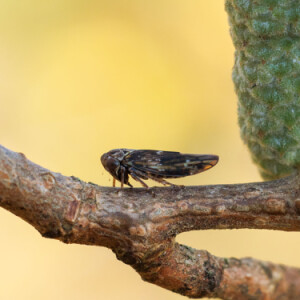Hanging out
Unexpectedly, the sun came out today - defying the weather forecast, which continued to predict cloud even as the garden glowed in the low, golden sunlight. Over the course of the morning the temperature slowly climbed, and by the time I ventured out at around noon there were quite a few invertebrates about, including a couple of late hoverflies.
I found the Acericerus ribauti leafhopper in the extras basking on a hazel catkin, which is fairly unusual - they're usually more secretive than that - but the poor thing was still too cold to fly, or even leap, so he spent a rather torturous half-hour dodging around the catkin and the nearby twigs, with me and my macro lens in hot pursuit. In the end he did warm up enough to go, and duly went, leaving me with a large number of poor photos and just one or two acceptable ones. The shot I've posted is quite interesting in that is shows his piercing mouthparts, though I don't believe he was actually eating. This species is said to be a maple specialist but may not have read that section of the book: I rarely find any on our maples, but frequently beat specimens from other trees and shrubs.
Fun though the hopper is, if you've been following my ramblings for any length of time you won't be surprised by the image I've chosen to feature: even one pair of cuddling weevils might well have made it to the top spot, but two pairs are simply irresistible. Should you be unfamiliar with these tiny guys, they're seed weevils called Oxystoma pomonae, and they're about 3mm long. Each of the pairs is mixed, with a female underneath - they're slightly larger, and have a longer rostrum, or snout - and a male on top.
During the autumn the males seek out females and climb aboard like this, and the females - not obviously incommoded by their passengers - walk around until they find somewhere to roost through the winter. They don't seem especially fussy as to roost sites: I've found them in a Lawson cypress, on various deciduous trees, and sometimes on shrubs such as photinia and viburnum. This quartet is on another of the hazels in the wild garden, which I find is a good place to look for them. They usually start out on the under sides of leaves, but as the autumn progresses and the leaves fall they move onto twigs, often settling on buds or catkins, where they will stay until February or March. Quite a few beetles overwinter in groups, for safety and the sharing of warmth, but I wonder whether the behaviour of these Oxystoma pomonae males might not have at least as much to do with securing a potential mate, so as to be in pole position for breeding in the spring.


Comments
Sign in or get an account to comment.


